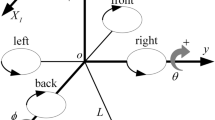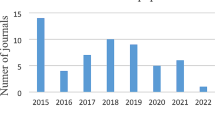Abstract
In this paper, a type-2 fuzzy neural network (T2FNN) controller has been designed for a class of nonlinear time-delay systems using the feedback error learning (FEL) approach. In the FEL strategy, the T2FNN controller is in the feedforward path to overcome the nonlinearity and time delay and a classical controller is in the feedback path to guarantee the stability of the controlled system. Using the Lyapunov–Krasovskii stability theorem, the adaptation rules for training of T2FNN controller have been achieved in a way that, in the presence of the unknown disturbance and time-varying delay, the tacking error becomes zero. In the proposed stability criteria and adaptation laws, since just the training error is utilized, i.e., the mathematical model of the system or its parameters is not needed, the overall training and control algorithm is computationally simple. In the present study, the effect of delay has been considered in tuning the T2FNN parameters and, therefore, the performance of the proposed controller has been improved. The proposed strategy has been applied to systems with time-varying input delay and measurement noise and compared with indirect type-1 fuzzy sliding controller. The effectiveness of the proposed controller is shown by some simulation results.













Similar content being viewed by others
References
Abid H, Toumi A (2016) Adaptive fuzzy sliding mode controller for a class of SISO nonlinear time-delay systems. Soft Comput 20:649–659
Abiyev RH, Kaynak O (2010) Type 2 fuzzy neural structure for identification and control of time-varying plants. IEEE Trans Ind Electron 57:4147–4159
Allouche M, Dahech K, Chaabane M (2017) Multiobjective maximum power tracking control of photovoltaic systems: T-S fuzzy model-based approach. Soft Comput 1–12. https://doi.org/10.1007/s00500-017-2691-7
Almaraashi M, John R, Hopgood A, Ahmadi S (2016) Learning of interval and general type-2 fuzzy logic systems using simulated annealing: theory and practice. Inf Sci 360:21–42
Almohammadi K, Hagras H, Alghazzawi D, Aldabbagh G (2016) A zSlices-based general type-2 fuzzy logic system for users-centric adaptive learning in large-scale e-learning platforms. Soft Comput 21:6859–6880
Amador-Angulo L, Castillo O (2016) A new fuzzy bee colony optimization with dynamic adaptation of parameters using interval type-2 fuzzy logic for tuning fuzzy controllers. Soft Comput 22:571–594
Antão R, Mota A, Martins RE (2016) Model-based control using interval type-2 fuzzy logic systems. Soft Comput 22(2):607–620
Arefi MM, Zarei J, Karimi HR (2014) Adaptive output feedback neural network control of uncertain non-affine systems with unknown control direction. J Frankl Inst 351:4302–4316
Bhatia NP, Szegö GP (1970) Stability theory of dynamical systems. Springer, New York
Biglarbegian M, Melek W, Mendel JM (2011) Design of novel interval type-2 fuzzy controllers for modular and reconfigurable robots: theory and experiments. IEEE Trans Ind Electr 58:1371–1384
Boyd SP, El Ghaoui L, Feron E, Balakrishnan V (1994) Linear matrix inequalities in system and control theory. SIAM, Philadelphia
Castillo O, Melin P, Alanis A, Montiel O, Sepúlveda R (2011) Optimization of interval type-2 fuzzy logic controllers using evolutionary algorithms. Soft Comput 15:1145–1160
Du H, Zhang N (2009) Controller design for time-delay systems using genetic algorithms. Eng Appl Artif Intell 22:397–400
Gao Q, Feng G, Xi Z, Wang Y, Qiu J (2014) Robust control of T-S fuzzy time-delay systems via a new sliding-mode control scheme. IEEE Trans Fuzzy Syst 22:459–465
Guo L, Gu H, Zhang D (2010) Robust stability criteria for uncertain neutral system with interval time varying discrete delay. Asian J Control 12:739–745
Hale JK, Lunel SMV (2013) Introduction to functional differential equations. Springer, Berlin
Ideta AM (2006) Stability of feedback error learning method with time delay. Neurocomputing 69:1645–1654
Kawato M, Furukawa K, Suzuki R (1987) A hierarchical neural-network model for control and learning of voluntary movement. Biol Cybern 57:169–185
Khanesar MA, Kaynak O, Yin S, Gao H (2015a) Adaptive indirect fuzzy sliding mode controller for networked control systems subject to time-varying network-induced time delay. IEEE Trans Fuzzy Syst 23:205–214
Khanesar MA, Kayacan E, Reyhanoglu M, Kaynak O (2015b) Feedback error learning control of magnetic satellites using type-2 fuzzy neural networks with elliptic membership functions. IEEE Trans Cybern 45:858–868
Koo GB, Park JB, Joo YH (2014) Decentralized fuzzy observer-based output-feedback control for nonlinear large-scale systems: an LMI approach. IEEE Trans Fuzzy Syst 22:406–419
Kumbasar T (2014) A simple design method for interval type-2 fuzzy PID controllers. Soft Comput 18:1293–1304
LaSalle JP (1976) The stability of dynamical systems. SIAM, Philadelphia
Lin T-C, Roopaei M (2010) Based on interval type-2 adaptive fuzzy \(\text{ H }\infty \) tracking controller for SISO time-delay nonlinear systems. Commun Nonlinear Sci Numer Simul 15:4065–4075
Liu Y-J, Tong S (2016) Barrier Lyapunov functions-based adaptive control for a class of nonlinear pure-feedback systems with full state constraints. Automatica 64:70–75
Liu Y-J, Tong S, Li D-J, Gao Y (2015) Fuzzy adaptive control with state observer for a class of nonlinear discrete-time systems with input constraint. IEEE Trans Fuzzy Syst 24:1147–1158
Maldonado Y, Castillo O, Melin P (2013) Particle swarm optimization of interval type-2 fuzzy systems for FPGA applications. Appl Soft Comput 13:496–508
Marouf S, Esfanjani RM, Akbari A, Barforooshan M (2016) T-S fuzzy controller design for stabilization of nonlinear networked control systems. Eng Appl Artif Intell 50:135–141
Nakanishi J, Schaal S (2004) Feedback error learning and nonlinear adaptive control. Neural Netw 17:1453–1465
Perez J, Valdez F, Castillo O, Melin P, Gonzalez C, Martinez G (2017) Interval type-2 fuzzy logic for dynamic parameter adaptation in the bat algorithm. Soft Comput 21:667–685
Poursamad A, Davaie-Markazi AH (2009) Robust adaptive fuzzy control of unknown chaotic systems. Appl Soft Comput 9:970–976
Richard J-P (2003) Time-delay systems: an overview of some recent advances and open problems. Automatica 39:1667–1694
Ruan X, Ding M, Gong D, Qiao J (2007) On-line adaptive control for inverted pendulum balancing based on feedback-error-learning. Neurocomputing 70:770–776
Sabahi K, Ghaemi S, Pezeshki S (2014) Application of type-2 fuzzy logic system for load frequency control using feedback error learning approaches. Appl Soft Comput 21:1–11
Saravanakumar R, Ali MS, Hua M (2016) H\(\infty \) state estimation of stochastic neural networks with mixed time-varying delays. Soft Comput 20:3475–3487
Sheng L, Ma X (2014) Stability analysis and controller design of interval type-2 fuzzy systems with time delay. Int J Syst Sci 45:977–993
Singh M, Srivastava S, Hanmandlu M, Gupta J (2009) Type-2 fuzzy wavelet networks (T2FWN) for system identification using fuzzy differential and Lyapunov stability algorithm. Appl Soft Comput 9:977–989
Smith OJ (1959) A controller to overcome dead time. ISA J 6:28–33
Tsai S-H, Chen Y-A, Lo J-C (2016) A novel stabilization condition for a class of T-S fuzzy time-delay systems. Neurocomputing 175:223–232
Yu Z, Li S (2014) Neural-network-based output-feedback adaptive dynamic surface control for a class of stochastic nonlinear time-delay systems with unknown control directions. Neurocomputing 129:540–547
Zhou Q, Wu C, Jing X, Wang L (2016) Adaptive fuzzy backstepping dynamic surface control for nonlinear Input-delay systems. Neurocomputing 199:58–65
Zhu Q, Zhang T, Yang Y (2012) New results on adaptive neural control of a class of nonlinear systems with uncertain input delay. Neurocomputing 83:22–30
Ziegler JG, Nichols NB (1942) Optimum settings for automatic controllers, trans. ASME, 64
Author information
Authors and Affiliations
Corresponding author
Ethics declarations
Conflict of interest
The authors declare that they have no conflict of interest regarding the publication of this paper.
Ethical approval
This article does not contain any studies with human participants or animals performed by any of the authors.
Additional information
Communicated by V. Loia.
Appendix A
Appendix A
The time derivative of the Lyapunov–Krasovskii functional in Eq. (19) is derived as
and by considering the assumptions in Eqs. (2) and (5), we have:
The Lyapunov–Krasovskii stability requires:
Substituting the value from Eq. (18) we have:
Considering Eq. (17), we can get:
Combining Eqs. (16) and (A-5) gives (with an absolute value of \(e_{tr})\):
It is considered that \(\eta ^{{*}}\) is large as
By substituting the adaptation law for \(\eta \) in Eq. (20) into Eq. (A-6) and rearranging that for satisfying the mentioned stability condition, we have:
Equation (A-8) is in the form of four quadratic equations. This equation satisfies the Lyapunov–Krasovskii stability criterion only when:
where A, B, C, and D are the solutions of the equations. It should be noted that if \(b^{2}-4ac=0\) exists in Eq. (A-9), then A, B, C, and D are solved. (a, b, and c are the coefficients of the standard quadratic equation.) Therefore, \(b^{2}-4ac=0\) is calculated for the equations as follows:
Each of Eqs. (A-10)–(A-13) has two solutions (related to the T2FNN parameters). We suppose that \(\sigma _{1,1}\) and \({\sigma }_{1,2}\) are the solutions of \(\sigma _{1}\), \({\sigma }_{2,1}\) and \({\sigma }_{2,2}\) are the solutions of \(\sigma _{2}\), \(m_{1}\) and \(m_{2}\) are the solutions of m, and \(c_{1}\) and \(c_{2}\) are the solutions of c. All of the solutions satisfy Eq. (A-9) giving:
Choosing the values stated in Eqs. (21)–(24) makes \(\dot{V}(t)\) more negative, and it can be concluded that \(\dot{V}(t)<0\) and, therefore, the designed control system is Lyapunov–Krasovskii stable.
Rights and permissions
About this article
Cite this article
Ghaemi, S., Sabahi, K. & Badamchizadeh, M.A. Lyapunov–Krasovskii stable T2FNN controller for a class of nonlinear time-delay systems. Soft Comput 23, 1407–1419 (2019). https://doi.org/10.1007/s00500-018-3053-9
Published:
Issue Date:
DOI: https://doi.org/10.1007/s00500-018-3053-9




